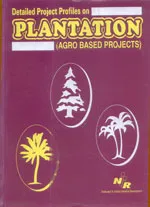***********Limited Edition- available in Photostat Version Only************
A plantation is a long, artificially-established forest, farm or estate, where crops are grown for sale, often in distant markets rather than for local on-site consumption. The term plantation is informal and not precisely defined. Plantations are developed on a large scale as the crops are grown for commercial purposes, not for local consumption. A plantation is always a monoculture over a large area and does not include extensive naturally occurring stands of plants that have economic value. Because of its large size, a plantation takes advantage of economies of scale. Protectionist policies and natural comparative advantage have contributed to determining where plantations have been located. Industrial plantations are established to produce a high volume of wood in a short period of time for each society. Plantations are grown by state forestry authorities (for example, the Forestry Commission in Britain) and/or the paper and wood industries and other private landowners. The plantation depends on a plentiful supply of cheap labor, not in the sense that its cost is low in relation to its productivity but in the absolute sense that wages are low because skills are few. For the plantation derives whatever economic advantage it has from its ability to mobilize unskilled labor to achieve greater economic return. Under certain circumstances the plantation, either private or public, enjoys distinct economic advantages over other types of farm organization. When it is desirable to introduce a new technology requiring a radical change in cultural practices, the plantation substitute’s supervision—supervisory and administrative skills—for skilled, adaptive labor, combining the supervision with labor whose principal skill is to follow orders. India has a long tradition of floriculture. Rose is the principal cut flower grown all over the country, even though in terms of total area, it may not be so. The larger percentage of the area in many states is used for growing scented rose. More than two thirds of this large area is devoted for production of traditional flowers, which are marketed loose e.g. marigold, jasmine, chrysanthemum, aster, tuberose etc. Mushroom is an exotic and nutritious source of vegetarian food. It is a major horticulture product all over the world and is also becoming popular in India. Fresh mushrooms have very limited shelf life but dried and packed mushrooms have considerable shelf life.
The content of the book includes information about plantation. The major contents of this book are project profiles of projects like teak plantation, eucalyptus tree plantation, cut flower (rose), mushroom (cultivation and processing unit), papaya cultivation, rubber plantation, Shisham plantations, Amla plantations, tea plantations.
Project profile contains information like introduction. Uses and applications, market survey, supplier’s addresses, plant economics, land and building, plant and machinery, other fixed assets, fixed capital, working capital requirement/annum, salary and wages/annum, utilities and overheads, total working capital/annum, cost of projects, total capital investment, cost of production/annum profit, rate of return, B.E.P.
This book is very useful for new entrepreneurs, technical institutions, existing units and technocrats.

Detailed Project Profiles On Plantation (Agro Based Projects)
Format: hardcover
Code: NI18
Pages: 166
ISBN: 8186623027
Publisher: National Institute of Industrial Research
$0
₹0
1. Teak Plantation
2. Eucalyptus Tree Plantation
3. Cut Flower (Rose) (Floriculture)
4. Mushrooms (Eou) (Cultivation And Processing Unit)
5. Papaya Cultivation
6. Rubber Plantation
7. Shisham Plantation
8. Amla Plantation
9. Tea Plantation
Customer Reviews
No reviews yet. Be the first to write one!

